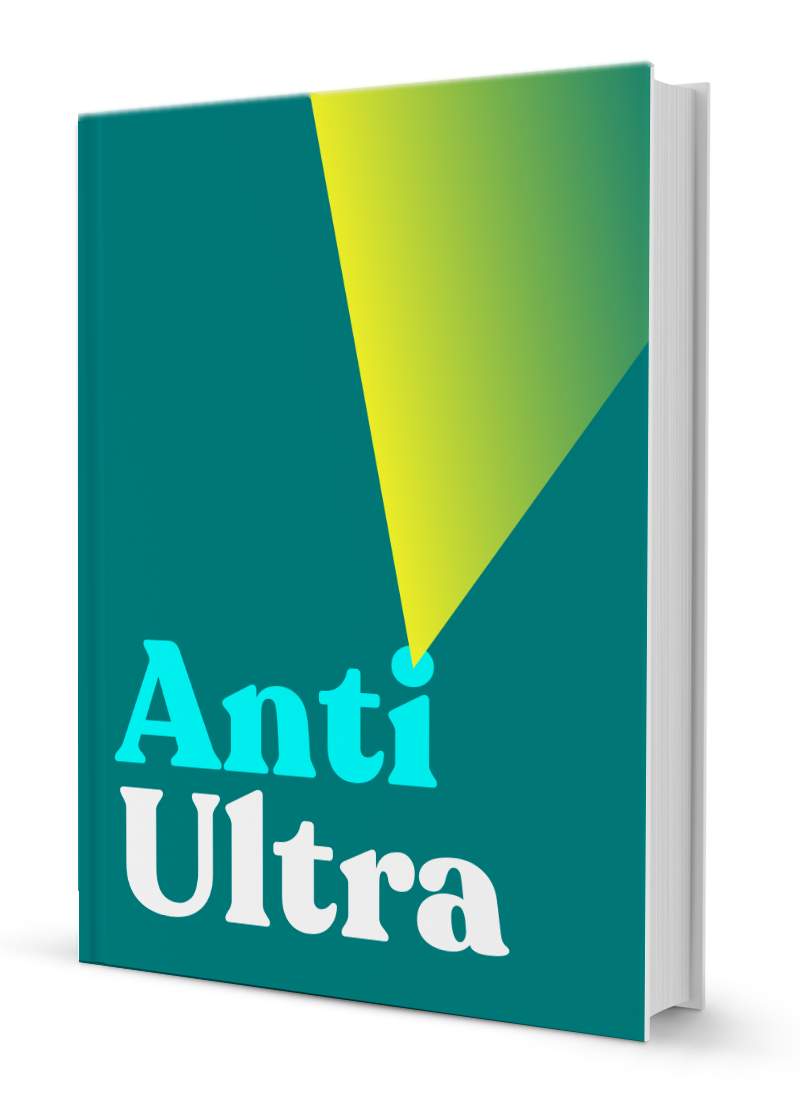

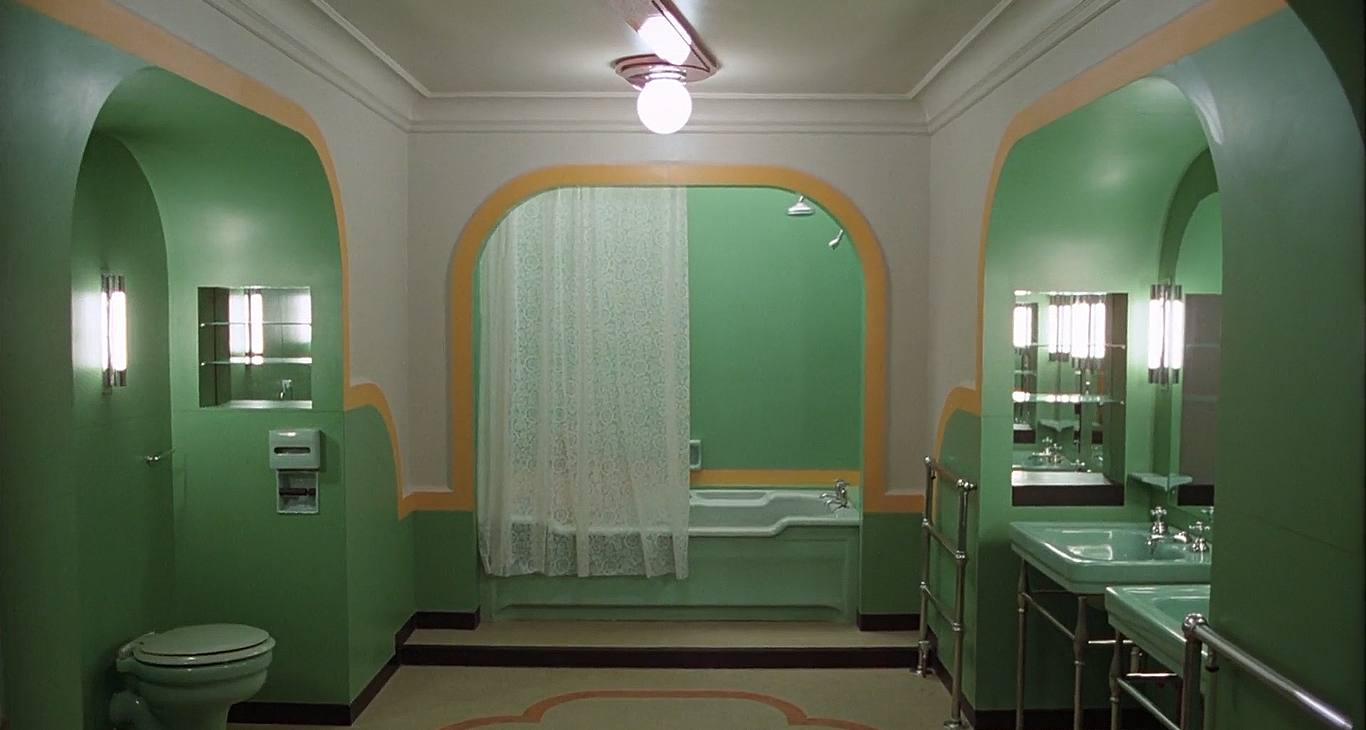
To the enduring puzzlement of critics, Kubrick’s movie bears only a loose resemblance to the original Stephen King story, a novel which Kubrick described as "hackneyed," and lacking-in-insight or fineness of writing.
There was a reason for the movie’s poor critical reception, but public acclaim: On a subconscious level Hollywood-insiders, Stephen King, and their lackeys in the ‘press’ hated The Shining because they sensed — albeit many of them unconsciously — that the film was an attack on the industry. And it was. Stephen King has repeatedly said the movie made him feel “deeply disappointed,” and that much of his original story was "wasted.”
Eyes Wide Shut cost Kubrick his life. Indeed, this later film was too transparent in its attacks on the Freemasonic pedophiles. The Shining, however, was much more covert in critiquing the 'elite'. So much so that many of the occultists, including Jack Nicholson himself, were not aware that Kubrick was dismantling their world, and mopping up their horrors:
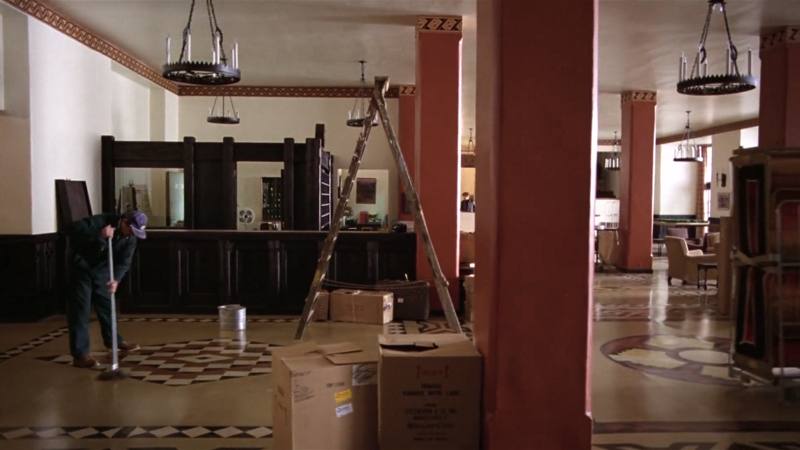
What do you see in the above frame taken from The Shining? A man mopping the floor; an abandoned ladder, a ceiling lamp? Remember, that Kubrick was the master of the subliminal. Look again. What happens if we flatten the floor pattern and center the key elements of the shot:
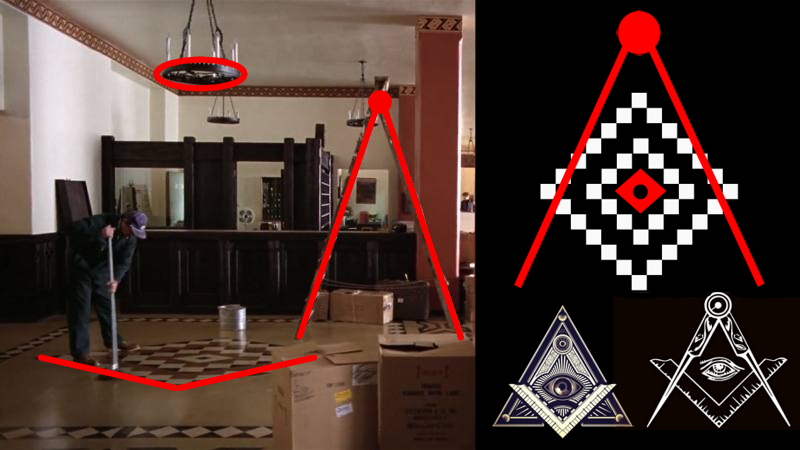
If we accept, then, that Kubrick was making an entirely different movie from the one he told people he was: In Kubrick’s ingenious allegory, Jack Nicholson (unknowingly) plays himself as the haunted ‘Jack Torrance’ (more on that later), while Kubrick is represented in the movie as ‘Danny’: the little boy searching around the ‘hotel’ corridors on his steadycam-tracked tricycle, trying to make sense of the world.
Then there is the theme of the previous ‘caretaker’ of the Overlook Hotel, who killed ‘the two little dead girls’.
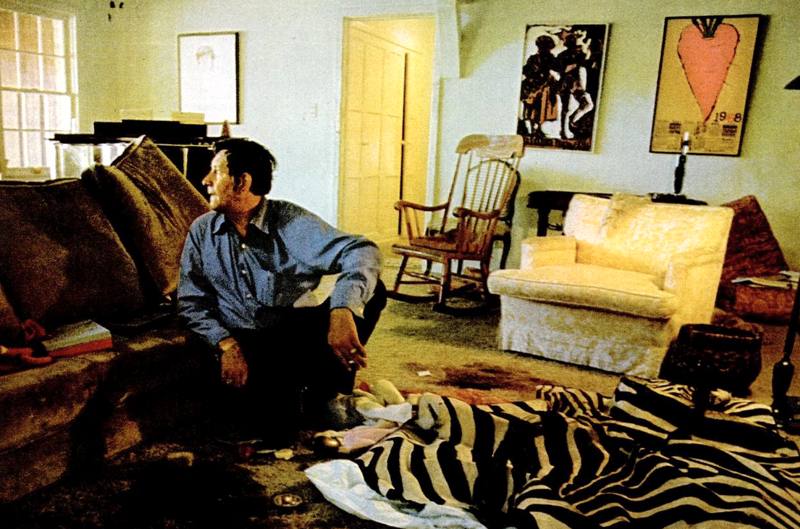
Photo: Roman Polanski posing for a photographer from Life magazine. Polanksi invited Life magazine to his Hollywood home shortly after two girls were killed in it by CIA-asset Charles Manson's occult group. Sharon Tate's blood can still be seen on the floor. Polanski crouches next to the skin of a slaughtered animal, a black and white zebra.
Checkerboard patterns reminiscent of the Freemasonic black and white iconography occur and reoccur throughout The Shining. Most obviously there are the floors of the Overlook Hotel, with their checkerboard framing.
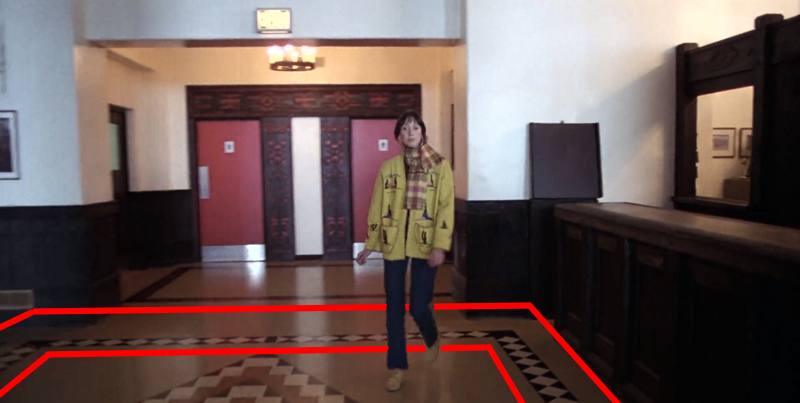


Naturally, there is a problem with this interpretation: This window was designed for the Ahwahnee hotel by Jeannette Dyer Spencer, at the behest of Phyllis Ackerman and Arthur Upham Pope. How, then, could the windows in The Shining be another example of Freemasonic occultism if they were not designed exclusively for the movie? The answer is disturbing: The hotel on which Kubrick based his movie may have been one of the places frequented by the 'elite' occultists which the movie critiques. The Ahwahnee hotel was subject to precisely those 'elite' influences that would have shaped the design of many occult buildings of the age.
Remember that, when shooting Eyes Wide Shut, Kubrick used a real-life Rothschild Mansion as the location for the ritual abuse. Mentmore Towers was designed for the Baron Mayer de Rothschild as a 'country home'. Kubrick has a well-evidenced history of drawing real-life elements into his allegories.
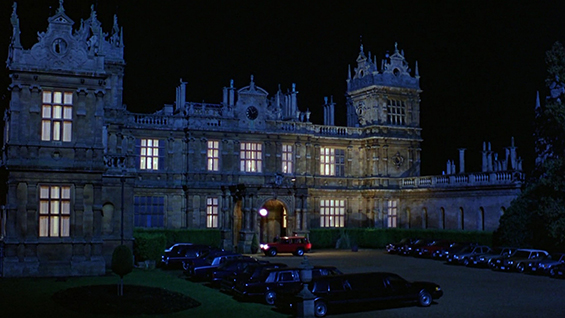
Although the Overlook Hotel, and Ahwahnee hotel on which it is based, appears to pay homage to 'Native American' patterns and fabrics, this was only a superficiality in the minds of the original architects. As historians at the National Park Service observed:
Although several Native American families lived in Yosemite Valley at the time the [Ahwahnee] hotel was constructed, and many of the women created and sold baskets to tourists for income, Ackerman and Pope did not consult with the Native American women who lived in the Yosemite area.
It is likely that Kubrick picked the Ahwahnee Hotel as the basis for his movie set precisely because its architecture embodied both the post-genocidal assimilation of 'Native American' art into the 'lodges' of the 'elite', and also because the parties held at the hotel during its heyday were precisely of the nature that he sought to expose in The Shining, and later in Eyes Wide Shut.
Specifically, consider the Ahwahnee Hotel's annual "Bracebridge Dinners". These originally included a three-hour quasi-bacchanalian feast which included a “mighty boar’s head", "baron of beef", "majestic peacock pie", and "flaming wassail". The dinners were followed by a "Bracebridge Dinner Procession" during which an "all-male chorus from San Francisco’s Bohemian Club" would sing.
The observant reader will note that this is the same "Bohemian Club" who run occult rituals at at Bohemian Grove. Here, the 'elite' stand by a lake in a forest, at the base of a forty-foot owl statue and do all kinds of intriguing things.
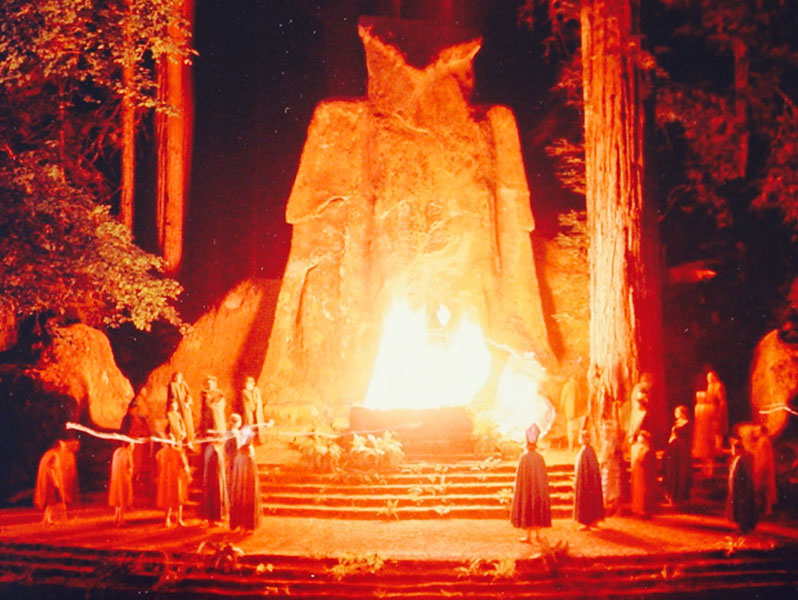
In The Shining, the hotel manager, Ullman, shows Jack's wife, Wendy, around the Overlook Hotel. We have this exchange:
Ullman
This place has had an illustrious past. In its heyday it was one of the stopping places for the jet set even before anyone knew what a jet set was. We had four presidents who stayed here. Lots of movie stars.
Wendy
Royalty?
Ullman
All the best people.
Readers will no doubt recall the visitors who have stayed in Hugh Heffner's Playboy Mansion, or Epstein's island. Royalty? All the best people.
The Ahwahnee Hotel, in our reality, has a similar 'alumni' of 'all the best people'. Shirley Temple, Charlie Chaplin, Greta Garbo, Walt Disney, Winston Churchill all stayed at the Ahwahnee in its 'golden' years. What of the presidents? We have Ronald Reagan, Herbert Hoover, Dwight D. Eisenhower, and John F. Kennedy (who reportedly had his orthopedic mattress helicoptered up to the hotel).
Remember: All the best people.
Royalty? Undoubtedly more often than the historical record officially notes, but for certain there was: The Emperor of Ethiopia (1954); King Baudouin of Belgium (1959); Queen Ratna of Nepal (1960); and Mohammed Rezi Pahlavi, the exiled Shah of Iran (1962). Then, three years after the release of Kubrick's movie, Queen Elizabeth and, notorious pedophile, Prince Philip (father of Epstein's friend Prince Andrew) stayed at the Ahwahnee for three days, occupying the entire hotel with their entourage in tow.All the best people.
We encounter an additional problem with interpreting the architecture of The Overlook Hotel: The Freemasons (an occult pedophile ring) have a habit of adopting popular architectural styles as disguise, and as subversion. Their occultism is an inverted form of many other religious symbol-sets, and Masonic temples across the USA can be seen in a variety of disguises: Some show an Egyptian theme, others a Persian revivalist style, and others, like the Overlook Hotel, which is our cinematic 'stand in' for a Masonic 'lodge', clearly adopts many of the graphic motifs of the 'Native American' cultures that the colonialists 'corrected' (to use the terminology of Grady in The Shining).
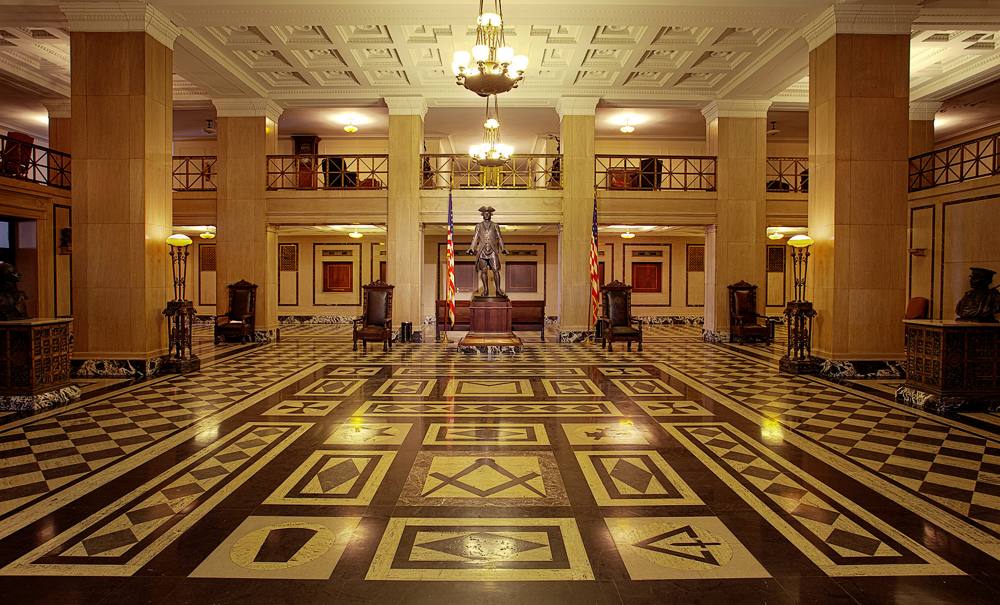
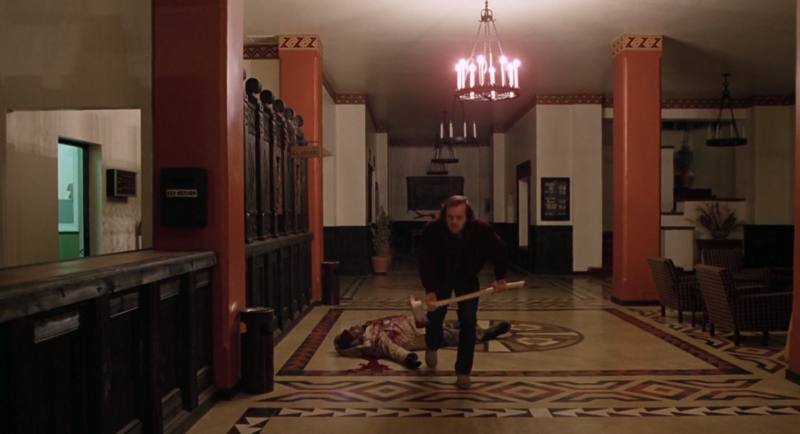
The 'understanding' promised to higher-ranking Freemasons is, of course an illusion. This 'understanding' only arrives when the Freemasonic initiate realizes that the Freemasons are a giant kompromat-gathering mafia. The Masonic system is designed by the powerful to trauma-program children and puppeteer adults. With this in mind, we can see how the Overlook Hotel, and its 'Native American' patterns are a disguise; one of many disguises in which the occult 'elite' dress their 'lodges'.
On the topic of kompromat (blackmail material) in The Shining, there appears to be metaphorical 'kompromat' framed all over the walls of the hotel. All photo frames are the same size, covering most walls of the ground floor. They recall, perhaps, walls of Polaroids in the Playboy Mansion, or a CIA office. Surely no real-life hotel would be quite so obvious and brazen in showing off its past guests?On the topic of kompromat, Danny is warned never to go into the hotel's Room 237. We later discover that this is a room in which beautiful women metamorphose into decaying corpses. We can speculate that Kubrick was himself warned not to enter any similar 'Room 237' while in Hollywood. The CIA were (and still are) running numerous honey-traps across Hollywood. Kubrick's knowledge of how Hollywood 'functions' may, in part explain his insistence on never leaving England during the later part of his filmmaking career. The publicized reason for this was Kubrick's fear of flying.
Interestingly, the room in which Jack first experiences his 'corruption' is painted green. It is a Green Room. Anyone who works in entertainment will know that entering a 'Green Room' is an oft-repeated ritual prelude to any appearance as a celebrity on television.
Room 237 is likely to be an allegory for the rooms at Hefner’s Playboy Mansion, and elsewhere, in which CIA’s kompromat operations and MK Ultra programming take place.
Before a person is elevated through the ranks of the Hollywood 'elite', kompromat is gathered to ensure their compliance with the studio's demands, and to guarantee to those higher up the pyramid that the 'actor' will not 'go rogue' at some point and create movies which challenge the status quo. Look at the doors to Hugh Hefner's Study. Again, we see what could be interpreted as Freemasonic iconography.
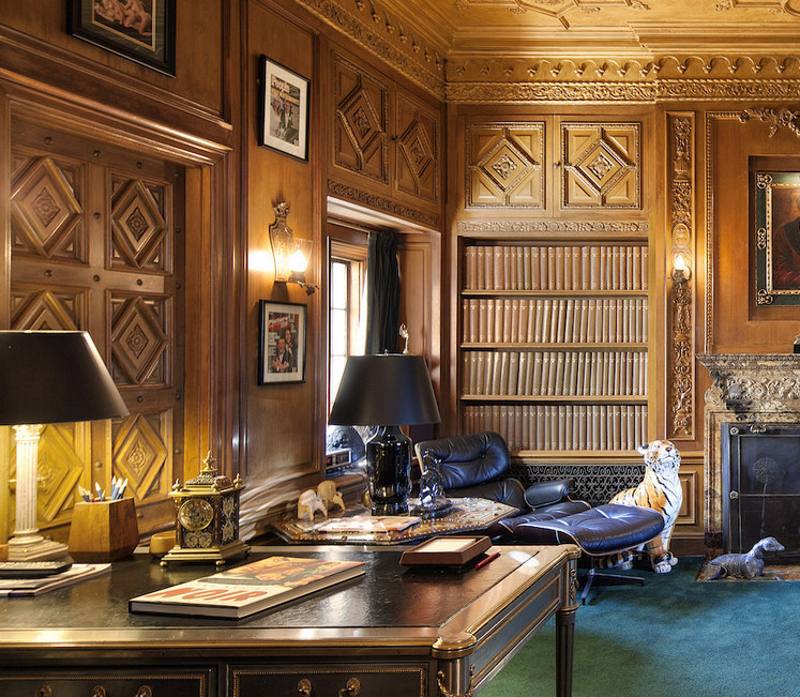
In fact, Hefner's study doors are uncannily similiar to the doors on the Overlook Hotel.
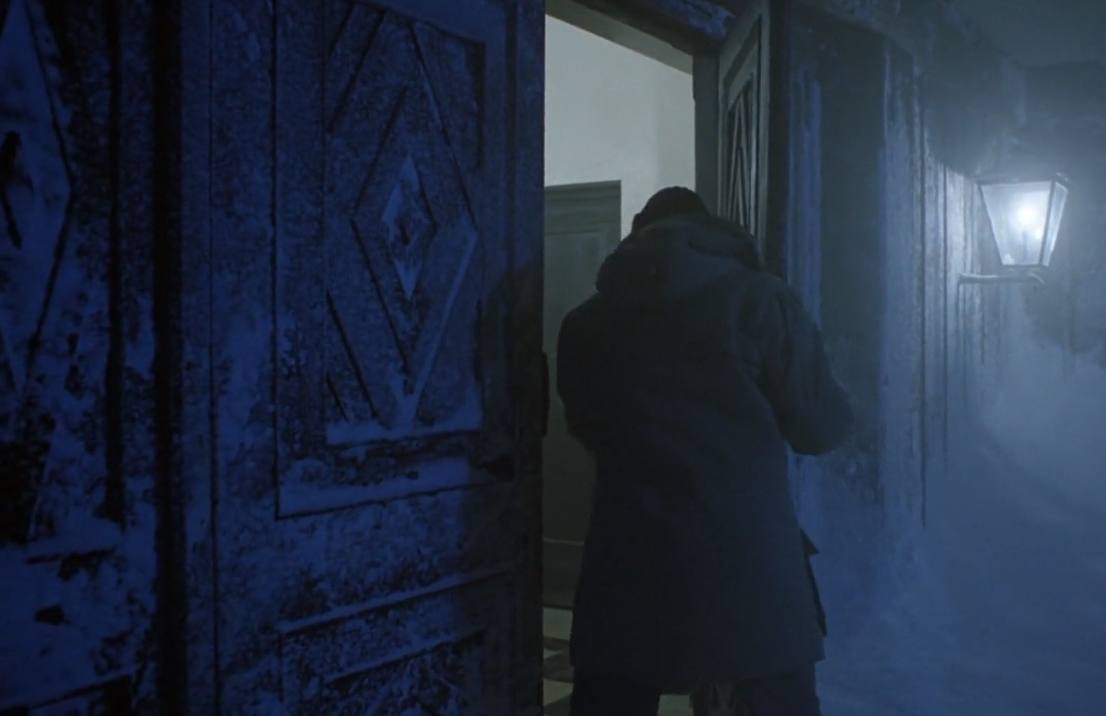
The 'Green Room' is tied to the ‘Red Room’ ('redrum' in The Shining). Again, this term is in common use among abusers. Many well-known figures in Hollywood will have found themselves lured into a 'Red Room' at the Playboy Mansion, and elsewhere, where extreme kompromat is gathered, or violence, even murder, enacted.
In other words: Green Rooms are rooms where beautiful women, or men, reveal themselves to be, metaphorically, rotten corpses (CIA assets). They provide the 'celebrity' with their earliest induction to the Hollywood 'club'. The celebrity-to-be is lured into a compromising situation and their seductive-liaison turns sour: The girl is a child; the girl is a prostitute; or some other permutation of shame that can be used to demoralize and scandalize the target. Metaphorically: the 'seducer' is revealed to be a 'corpse'.
Red Rooms ('red-rum') are places where violence is enacted, or demanded of those who are in the club. Allegiance to those in power in these networks is often demonstrated when members of the 'club' agree to commit an act of violence or murder for the 'club'. This violence occurs in the Red Room, or it is agreed on in the Red Room.
What then, is a 'Gold Room'? There is a Gold Room in The Shining which features prominently. On one layer of Kubrick's metaphor, this room can be taken to symbolize the riches of the gold-rush; establishment money; or the blood money of the depraved 'elite'. In our Hollywood Occult allegory, the Gold Room is likely to represent the inner-circle of those who fund the Hollywood pedophile-kompromat-murder rings. The Gold Room is their clubhouse; or innermost 'lodge'.
These color transitions from green, to red, to gold, may also symbolize the evolving 'status' of those who have 'risen' to the higher levels of the occult hierarchy. Consider the rituals that are demanded of the higher-degrees of Freemasonry, for example, which involve the murder and abuse of children, and adults. Notice also, how Jack Nicholson's character is dressed principally in green colored clothing for the first part of The Shining, and later prominently in red. This shift in Jack's clothing colors indicate his 'promotion' up the steps of the Hollywood Occult pyramid; ascending the steps of Freemasonry or a comparable order.
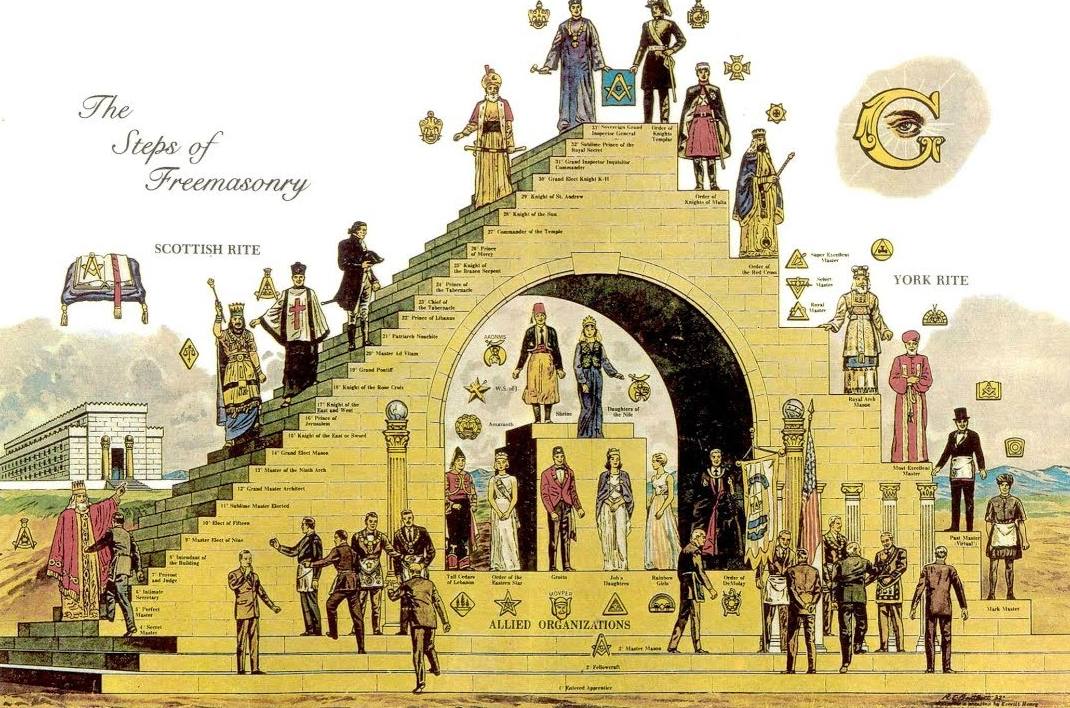
There is plenty of evidence in The Shining to indicate that Jack Nicholson, in our reality, has been tricked by Kubrick into acting in a film that is, in fact, a critique of Freemasonry; the CIA; The Playboy Mansion; Nicholson, and his pedophile friends.
Repeatedly, Nicholson is shown reflected in mirrors during critical scenes. Most obviously, there is the moment when, in the notorious Room 237, Nicholson watches his experience with a ‘beautiful’ woman turn into a nightmare. We can imagine this moment occurring for Nicholson in real life when he was first compromised by the CIA — as are so many actors. The Overlook Hotel takes on many subliminal connotations in Kubrick's movie; the Playboy Mansion in Beverly Hills, of course overlooks Hollywood. It is its own Overlook Hotel.
Kubrick retains some sensitivity to Nicholson’s plight. Kubrick recognizes that that there was some moment before Nicholson was turned by Hollywood into the person whose home hosted Polanski’s anal rape of a child in 1977.
Kubrick shows us the transformation that takes place in Nicholson in Room 237. He shows us, in metaphor, the deception that the CIA uses to entrap and control.

The genius of The Shining, as a movie, is that Kubrick’s real-world actions largely follow those of Danny in the movie itself. Danny learns the layout of the corridors and maze of The Overlook Hotel, and he ultimately uses this complex understanding to lead Jack Nicholson’s character into a confusing situation where he gets disorientated, lost, confused, and ultimately freezes to death.
It is precisely this same strategy that Kubrick uses during the filming of The Shining.
In Vivian Kubrick’s excellent documentary Making The Shining, Kubrick's daughter dissects the leading actor in this movie: Nicholson is clearly in a situation where he is receiving substantial script updates on a daily basis, with little time to critique or analyse the maze into which Kubrick is leading him.
Indeed, Vivian herself (whether consciously or not) joins her father in leading Nicholson deeper and deeper into the maze.
In her documentary, we see Nicholson between shoots repeatedly intimating towards to his crotch and unbuttoning his trousers in a sexually suggestive manner. This is not the only time he does this. In Vivan's short documentary (27 minutes) Nicholson feigns to pull out his cock on two different occasions. Vivian clearly establishes this sexual boundary-testing as part of Nicholson's character.
Vivian was seventeen at the time she shot this footage. “You look cute today in your red shirt, huh?” Nicholson says. And, when Vivian interrupts him during a phone call, “What if I had been talking business?”

On the subject of business, what was Jack Nicholson’s business in the Playboy Mansion to which he was inseparably affiliated? Rumors swirled of tunnels between Nicholson’s house and the Mansion which served as his second home. Warren Beatty later dismissed these rumors on a television talkshow, claiming that such a tunnel would have cost a billion dollars, to which another guest replied, “Was it worth it?”
Whether the tunnels existed or not is academic at this point, the CIA have spent years doing ‘work’ on the Playboy Mansion and it is probably beyond the skills of any archaeologist to undo whatever 'the clowns' have subjected the property to over the last few years. Nonetheless, this mythology springs from a general awareness that Jack Nicholson may as well have had tunnels running from his house to the Mansion, so frequent were his appearances there.
In the opening scenes of The Shining, Jack Nicholson’s character is invited to an interview in which he will be the new ‘caretaker’ of The Overlook Hotel. Remember, in our allegory, the Hotel is The Playboy Mansion and the previous ‘caretaker’ is said to have ‘chopped his wife and kid up into little pieces’.
Polanski, it is well known, was a close friend of Hefner and they even appeared in the CBS TV show Playboy After Dark.
The previous ‘caretaker’ of The Overlook Hotel became an embarrassment to the ‘hotel’ and Jack is being given the chance to take over after the murders.
Although the Playboy Mansion did not exist as a formal construct at the time of the Tate Murders, the idea that it represented did: The CIA’s kompromat gathering and programming operation. MK Ultra was begun in 1953 and the Playboy Mansion was simply a more advanced incarnation of what had come before.
Kubrick was reaching for the metaphors he had available at the time, while constantly updating and reshaping the script and production-design as he quietly observed Jack Nicholson roaming about the movie set.
Just as Danny studies the hotel: Kubrick studies Nicholson. Just as Danny learns the layout of the maze in which he will trap his murderous ‘father’, Kubrick studies the ‘layout’ of Jack Nicholson who he will trap via the continual re-scripting of this ‘horror’ movie.
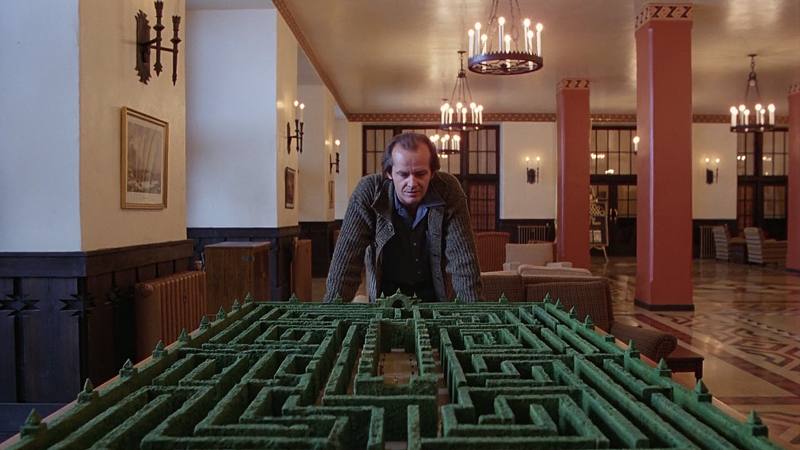
The disbelieving reader can be reminded that Kubrick was extraordinarily intelligent, was riding on the success of his movie 2001: A Space Odyssey, and was allegedly ‘bored’ with Hollywood. We can imagine that, in such a state of mind, it might occur to Kubrick that he could trick both Stephen King and Jack Nicholson into participating in a movie which would covertly lambaste them, and satisfy Kubrick’s disenchantment with LA.
While Polanski and Nicholson may have considered themselves to be the ‘big game’ hunters of Hollywood, Kubrick would eventually slay them both without their slightest awareness that it was happening. Possibly even to this day.
Nicholson has, of course, conveniently forgotten most everything from the past and is probably, at this point, impossible to charge with any crime connected with The Playboy Mansion, should one arise, given his ‘memory problems’.
Kubrick has taken two inner-circle ‘celebrities’ (we might say 'Gold Room' club members) and hoisted them slowly into sight on his celluloid gallows. Indeed, the keen eyed viewer will notice that, towards the end of The Shining, a red VW Beetle sits crushed by a juggernaut by the side of a snowy road. This is undoubtedly Kubrick’s reference to the original Stephen King book on which The Shining is based.
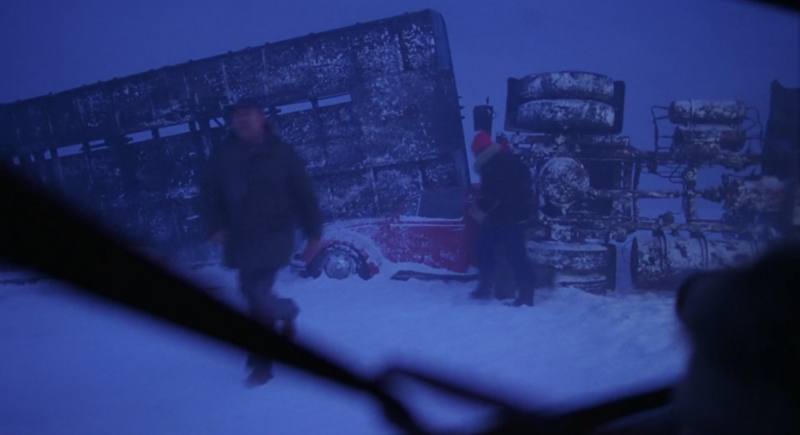
In the original book, the character, Jack, drives a red VW Beetle; in Kubrick’s version, a yellow one. We only see a red Volkswagen much later in the movie, crushed by the roadside. The implication is clear enough: Kubrick wants King to know that he has crushed his novel. Additionally, it may not be too far of a push to consider the origins of the Volkwagen Beetle and Kubrick's subliminal intent in changing the color of Jack's car from red to yellow.
Although ownership of Volkswagen cars has been normalized, and the company's history largely erased from public-awareness, it was Volkswagen who built and ran many of the Nazi concentration camps. Several of these concentration camps, like Arbeitsdorf, were literally built inside Volkswagen factories. These camps supplied slave-labor for Volkswagen. While the Volkswagen car in Stephen King's book is painted in red, Kubrick's version of the same car is painted in a shade of yellow. This color recalls the exact color of the 'Jude' (Jew) stars that the Nazis forced Jewish citizens to wear during the holocaust.
Kubrick appears to have made extremely conscious decisions regarding patterns and colors throughout The Shining. It is not unreasonable to consider whether — by depicting Jack's Volkswagen in Jewish-armband yellow — Kubrick is referencing the tidal-waves of blood, politely contained behind the 'elevator doors' of 'polite' German 'society'. To this day, German corporations continue to profit from the deaths of those millions who perished in the holocaust. Kubrick's movie hints, then, at the psychological-reality that today's Volkswagen factories are modern haunted houses. These factories are their own 'Overlook Hotels' of horror and denial, also staffed by demented 'caretakers'.
The Shining may represent the most complex, intelligent, and multi-layered trolling of Hollywood ever conceived. Only Wes Craven’s Scream franchise comes close to this. Kubrick’s trust here is astonishing: He must have hoped that, perhaps many years after his film is released, enterprising minds — ones that ‘shine’ like Danny’s in The Shining — might be able to decipher the allegory; to heed its warnings.
Throughout The Shining, Kubrick gestures towards The Playboy Mansion, the CIA, and MK Ultra. He cannot speak their names out loud, and indeed it ultimately cost him his life merely to allegorize them more brazenly later in his career. Witness the personal repercussions of Eyes Wide Shut.
Let us return to the opening scenes of The Shining. As Jack waits for his tour of The Overlook Hotel, what is that in his hand?
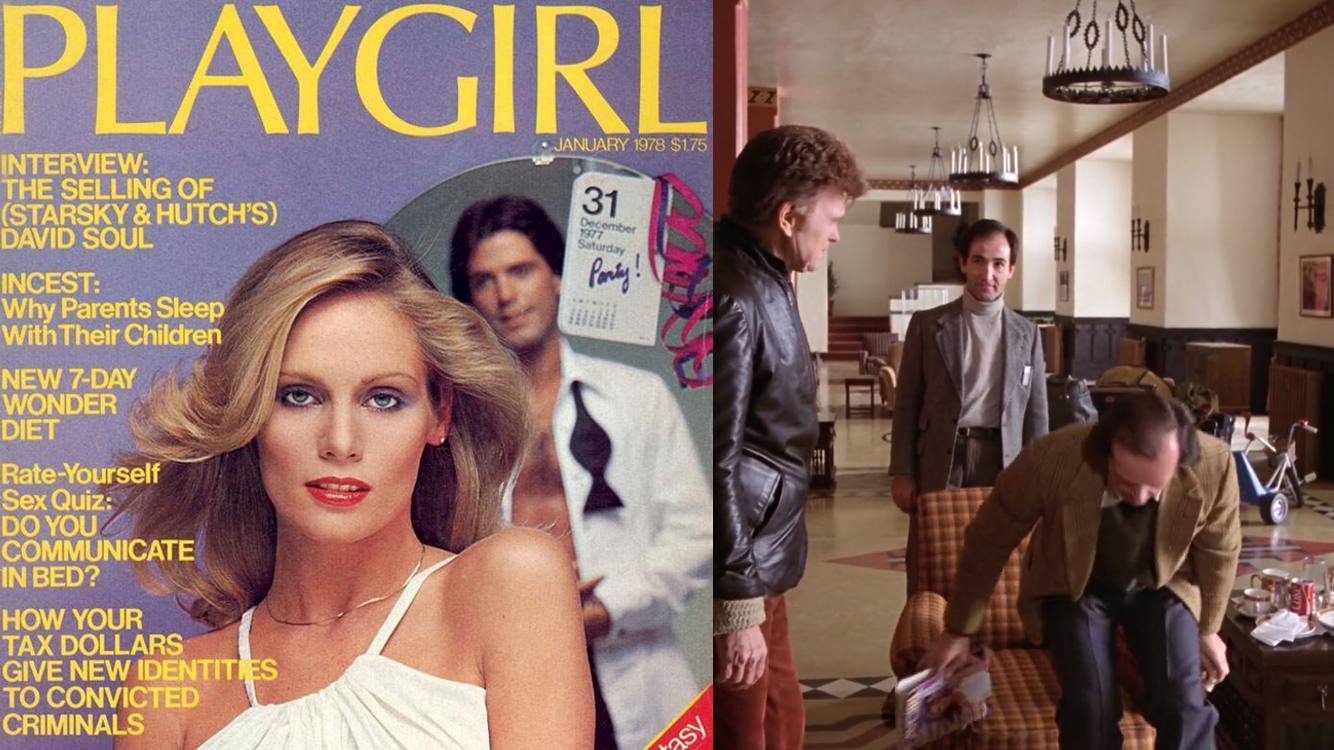
It’s a real-life, January, 1978 copy of Playgirl Magazine. This was an issue in which there was clearly an article about incest, and an article about a "dead-end affair" Why is there a Playgirl magazine in the lobby of a hotel? Our allegory grows in substance.
Later, we find Jack has spent weeks typing mad garbage on a typewriter. His wife Wendy discovers that it reads, “All work and no play makes Jack a dull boy”:
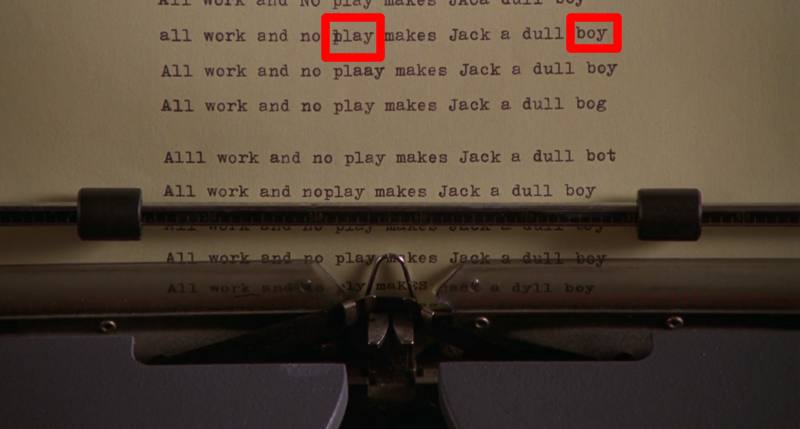
Look again. All work and no PLAY makes Jack a dull BOY. Playboy. Coincidence? The reading of tea-leaves? Let’s looks some more because these ‘coincidences’ begin to turn into constellations of meaning as we move through the film.
Remember: Kubrick cannot overtly state his topic or the game will be up, he must speak with us through these subtle, emerging constellations:
Mis-spellings on the other sheets of paper add the word 'Adult'.
Now let’s return to the two little dead girls, who say, "Come and play with us Danny. Forever." Danny is offered the chance to join these two playmates who symbolize both the fate of Sharon Tate, but also the sixteen ‘little dead girls’ (all 'cursed' to have died before fifty years of age) who have orbited the Playboy Mansion. Not all girls died literally, however, many other 'deaths' were spiritual.
Consider Playboy playmate Paige Young (found shot in the head, while mysteriously, simultaneously overdosed from barbiturates). Or Chloe Goins (raped at the Playboy Mansion by Bill Cosby with Hugh Hefner as accomplice). Or Brooke Shields, who Hefner used in his pedophile ops (photographing and publishing photographs of Shields at just eleven-years-old, posing naked as if she was an adult model). Later Shields reported that she blocked out the sexual abuse.
These are just a few examples. Then there are those 'little dead girls' (physically or spiritually) who were never found. Or never reported missing.
Later, Jack Nicholson is framed against an ‘Native American’ art work in the Overlook Hotel. On closer inspection, the apparently abstract patten shows three X’s. Triple X.

Then, in the middle of the tapestry, which seems to integrate both the XXX of the Playboy Mansion and the previously mentioned 'Eye of Providence' in the Freemason tradition, Kubric places Nicholson:
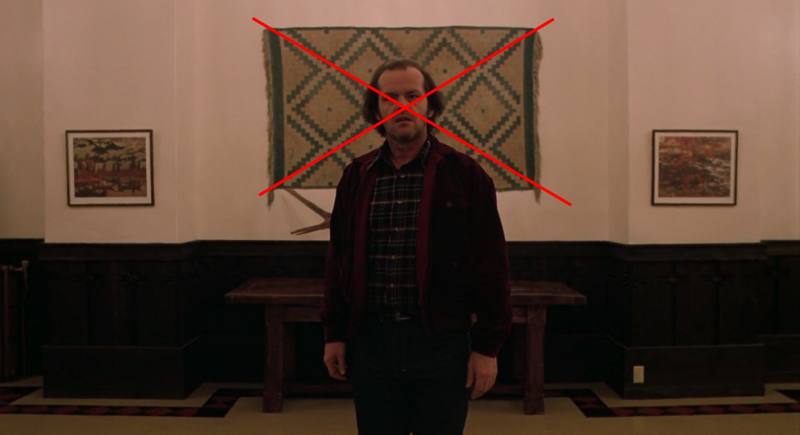
Coincidence? Perhaps. But it feels like Kubrick, tricycling around the movie set, has hit his target.
In this next shot we can see the elevator shaft in the overlook hotel. What do those two white balloons beside a column topped with an orange balloon, next to the elevator doors at the lower right-hand side of this frame indicate? The male genitalia comes to mind:
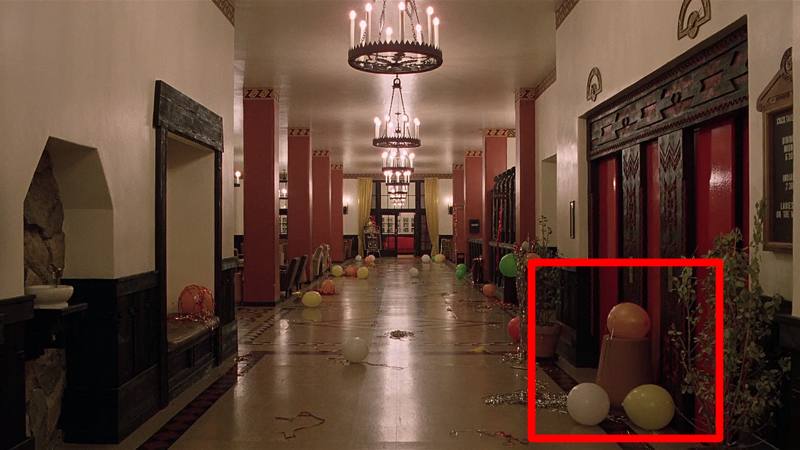
What then are the elevator doors? Why does Tony live in Danny’s mouth? Why do the elevator floor-indicators look like eyes? Why does Danny say that Tony moves ‘from my mouth to my stomach”? What is the meaning of the blood bursting out of the elevator ‘doors’?
The reader may feel unnerved at viewing The Shining with an eye for subliminal imagery, but Kubrick was deeply interested in subconsciously digested imagery. He reportedly asked master-subliminalist, the 'hidden-persuader', Austrian-born psychologist and marketing designer, Ernest Dieter "to collaborate on a previous movie, Dr. Strangelove, but the two couldn’t reach a mutually agreeable financial arrangement." (Freud on Madison Ave. p. 279).
What kind of a person is Jack Nicholson? Let’s avoid third-party reporting and return to Vivian Kubrick’s documentary, Making The Shining. As mentioned before, we open with Jack Nicholson telling Vivian, seventeen, that her top is cute, then asking why she’s filming him.
In Vivian’s Making-of documentary, we witness Kubrick, on numerous occasions, writing the movie he is shooting, while being filmed typing up these changes on the day of the shoot. The whole thing is so profoundly ‘meta’ that it is difficult to digest every dimension of what Vivian and Stanley are up to, but it feels like Vivian has been sent to spy on Nicholson under the pretext of the documentary. While this is difficult to prove, and may not have been a conscious act by either filmmaker, the result is clear: Both Vivian and Stanley slaughter Jack Nicholson, while Nicholson thinks he is slaughtering Wendy and Danny.
Every shot in Vivian’s documentary seems to dismantle Nicholson’s carefully crafted charm. The viewer is left to ponder: When is Nicholson not acting? Perhaps we never get to see behind the persona of Jack Nicholson the ‘actor’. Or, more disconcerting: Perhaps the character Nicholson plays in The Shining is his own self, unveiled. Moving beyond conjecture, what we can definitively see is the following:


Ullman
...We had four presidents who stayed here. Lots of movie stars.
Wendy
Royalty?
Ullman
All the best people.
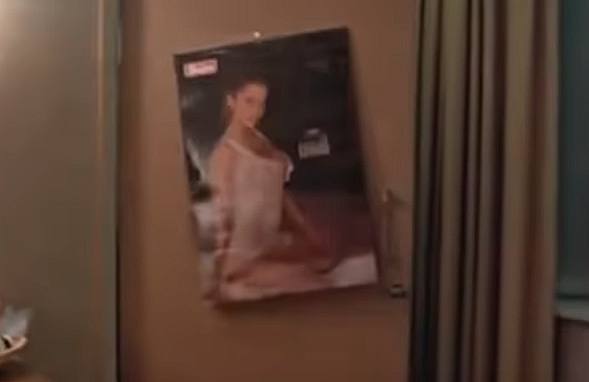
Let’s explore the famous scene in which Nicholson bursts through the door of the family living quarters at the Overlook Hotel.
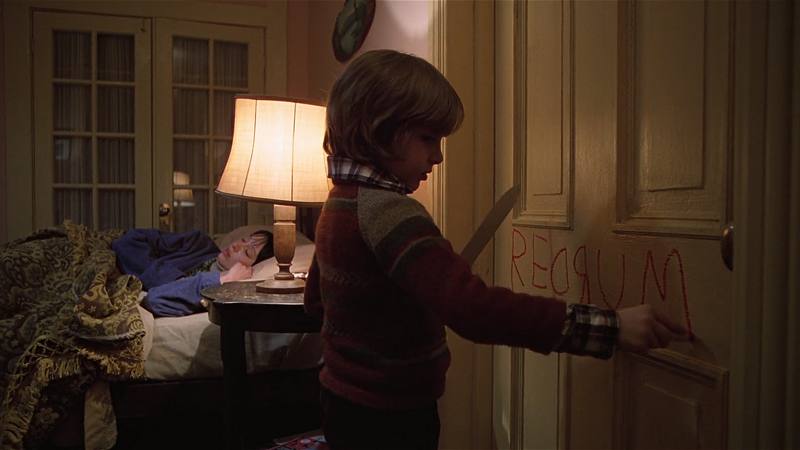
You’ll notice that Danny’s Scrawling of 'REDRUM' on the door, reflects in the mirror of the room to read ‘murder’, but also reflects on our culture, and the Tate murders. Danny’s lipstick scrawl recollects the writing left on the wall of Polanski’s house which read “Death to Pigs."

Later, Nicholson bursts through the bathroom door after saying, “little pigs, little pigs, let me come in!”
Also consider the similarities between Danny's blood-red lipstick writing:

And the message left in blood on the wall by the Manson group when they later killed Leno and Rosemary LaBianca. Here the parallel with 'Red Rum' seems all the more vivid, and there is the repetition of the character ‘R’ in the ‘He[a]lter skelter'. Remember: Kubrick was working with subliminal motifs.
The cynic will doubtless argue that these are tenuous connections. However, if they are valid they must necessarily be tenuous, or Kubrick will not have sufficiently disguised his theme from those in Hollywood who might otherwise stop the release, or making, of The Shining. Recall that our thesis here is that Kubrick intends to expose the occult aspects of Hollywood subliminally. He cannot be overt. The archetype of messages-written-in-blood-on-walls is undeniably linked to the Tate murders in the subconscious of the audience’s mind. It is extremely plausible that Kubrick is provoking this association in us.
To revisit an earlier point, it is also interesting that Kubrick links RedRum, or Red Room ('red rum') and 'murder' semantically in The Shining. The Red Room is both the location in The Shining where Jack Nicholson’s character is instructed to murder his family, but is presumably the place where the previous caretaker was instructed to murder his. We also have the broader definition of Red Room in the context of The Playboy Mansion or Masonic temple, our overarching allegory: 'Grand' buildings where abuse takes place.
By the time The Shining was in production, Kubrick had established himself as veil-lifter extraordinaire: A Clockwork Orange (1971) showcased the director's deep understanding of mind-control and the CIA's Project MK-Ultra. In this context, we cannot ignore the poster placed to the left of the Two Little Dead Girls that confront Danny in the games room:

Here we can see the word 'Monarch' written on the poster. Again, Kubrick has his plausible deniability: It is merely a ski poster. However, Kubrick will have been aware of 'Monarch Mind Control' programs which trauma-program children; which split children into part-selves, like twins. The avid viewer will also notice that, in the scene depicting these children slaughtered, they are badly bleeding in the crotch areas.
Kubrick said of Stephen King's original book, The Shining
"It is in the pruning down phase that the undoing of great novels usually occurs because so much of what is good about them has to do with the fineness of the writing, the insight of the author and often the density of the story. But The Shining was a different matter. Its virtues lay almost entirely in the plot, and it didn't prove to be very much of a problem to adapt it into the screenplay form."Notably Kubrick also eliminated most of the plot, which again, supports the theory that he did not option the book as a basis for the film, but as a tactical move to lure both King and Nicholson into the maze of The Overlook. Kubrick also said:
“To be honest, the end of the book seemed a bit hackneyed to me and not very interesting. I wanted an ending which the audience could not anticipate.”
It is the end of Kubrick's film that is both terrifying and redemptive. Kubrick makes up his own ending, completely disregarding Stephen King's "hackneyed" original. In Kubrick's movie, Jack, having smashed through Wendy's doors in the hotel with an axe (a metaphor for rape), then chases Danny into the Overlook's maze.
Still carrying the bloody 'axe' with which he 'raped' Wendy, Jack, behind Danny, says:
Jack
Danny! Danny! I'm coming!
You can't get away.
I'm right behind you.
As a survivor of abuse, I can remember the Freemasons who raped me saying things similar to this, "You can't get away." and "I'm right behind you," and the sexual-abuser's cry of disgusting-self-satisfaction, "I'm coming!" Kubrick's skill with subliminals is, again, impressive.
Many others have also noted Kubrick's subliminal association of the boy, Danny, with the symbol of a bear. The initially confusing moment in The Shining where Wendy discovers a person in a 'bear' costume in a sexual act with a fully-grown man, is her character's way of understanding what is being done to Danny, and other children like him, in the 'hotels' of the 'elite'. It is a form of denial:

As a survivor of ritual abuse, I am indebted to Kubrick for his bravery in speaking out for children who were tortured and raped by the Freemasons in their 'hotels' ('lodges') and 'temples'. There are many of us.
It will be apparent to most that the sexual abuse of Danny in The Shining is subliminally implied by the elevator gushing blood. Take a look closely at the eyes of the bear that represents Danny; the bear's red mouth recalls the elevator doors, and the eyes of the bear are the floor-indicators above the elevators:
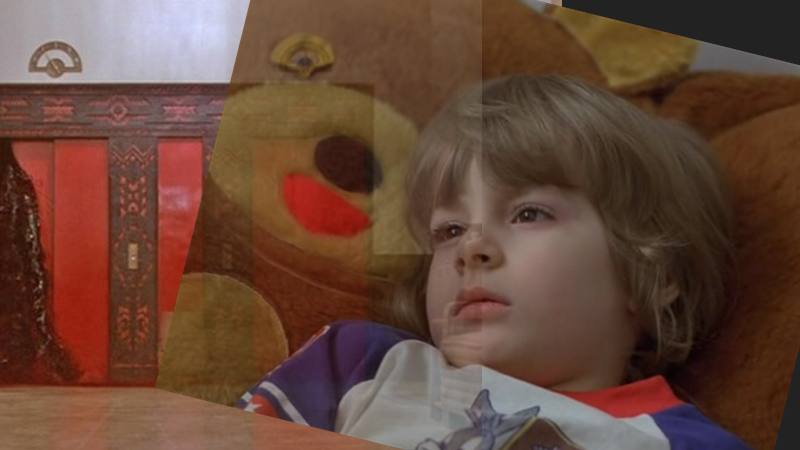
Kubrick intentionally mixes these symbols in the audience's subconscious: Danny becomes associated with the bear, and the bear with the elevator. These subliminal associations run deeper: The elevator moves the guests around the 'lodge' or 'hotel' and 'elevates' them up the ranks of the Freemasonic 'elite'. But the system runs on the blood of children which, ultimately bursts out of the elevator shaft, covering the 'hotel' in the indelible stains of its crimes.
In the aftermath of The Hoax, as the dust has settled, we can see that the real pandemic was the 'elite' abuse of children. Exposing this cost Kubrick his life. We will never know what other beautiful films the director might have made had he lived.
Nonetheless, Kubrick's life was a victory: The puzzle is cracked. The Shining and Eyes Wide Shut helped bring our awareness to the problem of child abuse. The narrative is now crumbling. Their world is over, the Hollywood 'elite' are now frozen, for all to see, in Kubrick's maze.

This article originally appeared in Psychedelic Review, Issue Number 12 (February 2023). It was lovingly transcribed here by psychedelic volunteers at The Castalia Foundation.

